|
|
|
|
|
Intel Pentium D 920 and 955 Extreme Edition |
|
Join the community - in the OCAU Forums!
|
Introduction, Intel's Dual Core Desktop Range
According to “Moore's Law”, the number of transistors on a chip roughly doubles every two years, resulting in more features, increased performance, and decreased cost per transistor. Almost in line with Moore’s law, Intel has been increasing transistor density in 2-year steps since 1990. The latest step is the move from 90nm to 65nm technology.
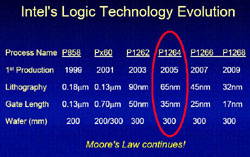 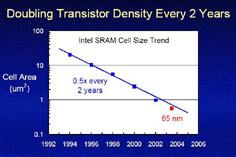
Since the end of 2005 Intel is the first and only manufacturer offering single and dual core processors based on 65nm production technology. 65nm generation transistors come with “gates”, that is the all important switch that turns a transistor on and off measuring only 35nm, approximately 30 percent smaller than the gate lengths on the earlier 90-nm technology.
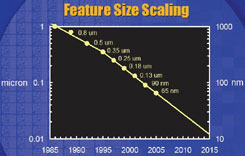 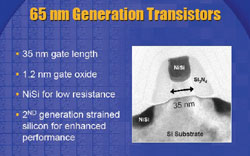
In addition to the higher density possible with the smaller transistors, Intel is claiming that 65nm transistors cut current leakage by four times at constant performance compared to 90nm transistors. Essential for this is the continuous improvement of the technology that allows shrinking the transistor size and squeezing more of them on a single chip. “65nm technology” is therefore precisely speaking not referring to transistor size, but the lithographic process, in particular the photo mask that is used to “burn” them onto the wafer.
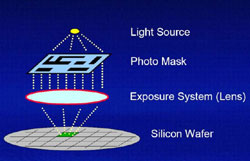
Although Intel has been leading the industry in production technology since they brought the first micro-processor to market in 1971, their move from 130nm technology to the finer 90nm process in 2002 didn’t go as well as planned. Users complained about high heat output and a lack of additional performance despite of higher core frequencies and bigger sized caches. Later AMD started pulling ahead with their more efficient Athlon A64 X2 series of dual core processors. Intel’s change to 65nm technology with “Cedar Mill” and “Presler” for desktops and “Yonah” for mobile computing was therefore important for them to regain ground in the desktop area and extent the lead in mobile computing.
Our main objective in this article is to find how much “better” the new 9xx dual core processor series based on the 65nm “Presler” core is in comparison to the older, 90nm based 8xx series. For this purpose we compare the entry level Pentium D 920 with a Pentium D 820 and the 955 Extreme Edition with the 840 Extreme Edition. Naturally we also wanted to see how Presler fairs against the competition. For this we included AMD’s recently released dual core flagship product, the FX-60 and the entry level X2 3800+. Given the early reports about good overclocking headroom with “Presler” we have ventured into this area in greater detail than usual. The “basics” of dual core computing, like the differences to “Multitasking” and “Hyperthreading” have already been covered in our article about Intel’s “Smithfield” core here. Today we just want to reiterate that a dual core processor is not the “magic bullet” for all occasions. It is most beneficial for multitasking; it can help for multithreaded or multiple applications. For many simple desktop jobs a single core processor can still be the better choice than a dual core processor running at a lower frequency for the same price.
The new 9xxx “Presler” core is based on the same “NetBurst” architecture with the deep 32-stage pipeline known already from “Prescott” and “Smithfield”. This micro-architecture allows for high core frequencies, but is also known for high power consumption and heat output. “Cedar Mill” and ”Presler” are Intel’s last micro-processors based on the NetBurst architecture. Although the design remains basically unchanged Intel is promising better performance and less heat with “Cedar Mill” and “Presler” because of smaller transistors and the use of second generation “Strained silicon”. Besides that, 65nm manufacturing technology has a substantial commercial benefit for the manufacturer because it allows producing more dies from the same 300mm wafer. Intel has currently 2 fabs producing 65nm processors, and will add 2 more during 2006. The change from 90nm to large scale 65nm production constitutes therefore a financial advantage for them, one that will hopefully also result in attractive retail prices. AMD has announced that they are preparing the change to 65nm technology in their new “Fab 32” in Germany for later this year.
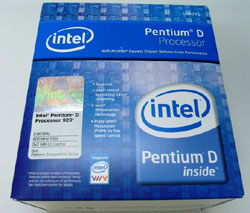
Intel’s dual core “Smithfield” core was made by joining 2 Prescott cores. “Presler” is built from 2 “Cedar Mill” cores that remain physically separated. That gives production flexibility because the same die can by used either for a single core “Cedar Mill” or a dual core “Presler” processor (9xx series) according to market demand. And unlike a “joined” solution only one die has to be discarded in case of defects, and not an entire dual core “package”. The 2 Pentium D cores are using a shared front-side bus to communicate with an off-die memory controller. This design means not only relative high (worse) memory latency, but also that both cores cannot communicate directly with each other. It remains a principle disadvantage versus the on-die memory controller implemented on the Athlon A64.
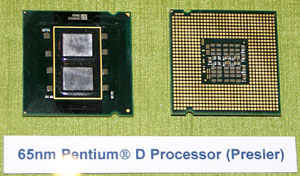
“Smithfield” has 2 x 1MB L2 cache. “Presler” comes with the 2 x 2MB. On-die cache allows for fast access to buffered data. A bigger cache can therefore increase performance. On the other hand with bigger cache, the number of transistors has gone up substantially. “Smithfield” was sporting 230 million transistors; “Presler” comes with 376 million. At the same time the die size has been reduced from 206 square mm (Smithfield) to 162 square mm. Intel’s “Hyperthreading” feature remains disabled for all Pentium D processors. It is reserved for the 840 and 955 dual core “Extreme Edition”. The 840 Extreme Edition was nonetheless a bit of a disappointment: It is running only with an 800 MHz system bus and is clocked at the same 3.20 GHz as a regular Pentium D 840. The “Presler” based Extreme Edition 955 runs with a 1066 MHz system bus. This is a clear advantage, because a higher bus frequency is providing better system bandwidth. The 955 XE is clocked at 13 x 266 MHz = 3.46 GHz which is 260 MHz higher than the 840 XE and still 60 MHz higher than the Pentium D 950 clocked at 17 x 200 MHz = 3.40 GHz. The 840 XE and 955 XE are the only Intel desktop processors available with an unlocked multiplier.
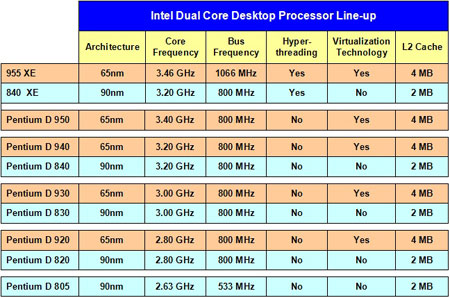
Last but not least it has to be mentioned that all new 65nm processors are featuring Intel’s “Virtualization Technology”. VT allows a platform to run multiple operating systems and applications in independent partitions. With virtualization, one computer system can function as multiple “virtual” systems. Intel continues to offer their 90nm based 8xx dual core processor along with the new 65nm products. And at the same time when the 9xx was launched they even introduced a new entry level “Smithfield” based dual core product, the Pentium D 805 clocked at 2.66 GHz and running with a 133 MHz front side bus frequency. In total Intel is currently offering 10 different products for dual core desktop computing.
|
|
Advertisement:
All original content copyright James Rolfe.
All rights reserved. No reproduction allowed without written permission.
Interested in advertising on OCAU? Contact us for info.
|

|


